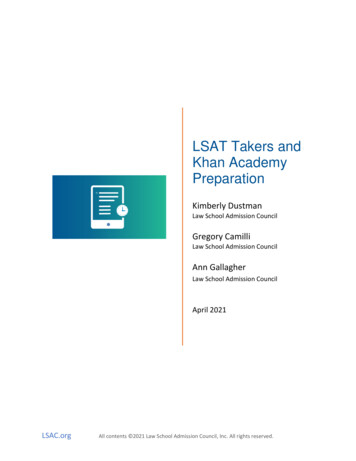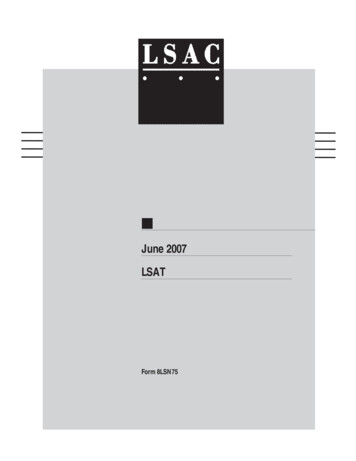
Transcription
Preparing for the LSAT
Webinar Overview What is on the LSAT? What is it testing?Materials you will want to have to prepareTutoring and other supplementary preparationWhy improving on the LSAT is more challenging thanimproving on other testsHow to form a long term strategy and study planSmall, everyday habits to improve LSAT performancesPreptests, PrepTest conditions, and How to ReviewBasic tips to improve in LR, LG, and RC We’ll stop for question breaksevery half hour. I’ll stick around a little after thewebinar is over to go over moreparticipant questions. Thanks for being here!
What is on the LSAT? What is it testing? The LSAT is a skills test with a small amount of content. On the SAT, you may remember the Verbal section tested vocabulary and readingcomprehension: Reading Comprehension tests skills with a little bit of content Vocabulary tests content with a little bit of skill The LSAT tests only a few skills, and it tests them frequently: Arguments: Argument structure. How arguments workReading Comprehension: Process written information answer questions.Deductive logic: Organizing variables in a scheme and drawing conclusions about itFormal logic: Translating English statements into logic in order to find inferences or missing assumptions.
Why Is This Important for Law School? It’s not clear – high performance on the LSAT and first year grades are correlated. .But, it’s probably true high performance on the GRE, or even the ACT, and first year gradeswould be correlated. The LSAT forces test-takers to read and respond in high pressure situations. This is probablysimilar to the everyday reality of some lawyers, and it is true that both in law school and thelegal profession you will do a lot of reading. Why the LSAT? We don’t know. Until we can take the GRE instead, we’ll do the best we can
What Materials Should You Use To Prepare? Recommended in order from left to right (Newest to older, there should be a new 10 volumetest coming out any day now). Probably want one of these for every 4 weeks you’re studying (round up). Other materials? Sure, but we’re not going to recommend any specifically.
The Newest Tests 81 was June 2017, so the 72-81 book should be out soon. Get it when it comes out! If it’s not out soon, these are going to the last tests you should take in the weeks leading upto test day They cost around 8- 10 each.
Tutoring and Other Supplementary Materials “Never train alone: it reinforces your mistakes” Think about baseball/softball. You can go to battingcages and practice your accuracy and power, but it’shard to see what you are doing while you are doing it.
Tutoring and Other Supplementary Materials Two solutions: You can record yourself andreview your stance, posture, swing, etc., or youcan get someone to watch you bat and do thesame analysis in real time. Recording yourself is similar to reviewing yourpractice tests (we’ll cover that later) Getting a coach is similar to getting a tutor! Tutors can help share strategies and insightsabout the material and your test-taking that youwouldn’t have realized without their insights.
Why Improving on the LSAT Is Not Easy Because the LSAT is a skills-based test, Test Day is moreanalogous to a sporting event or a skilled performance. You can’t “cram” for your recital or for a big game.Imagine doing your routine 30 times the night beforeyour performance – you’d get tired, you’d reinforce badmistakes.
Why Improving on the LSAT Is Not Easy Preparation is gradual – time spent studying should beevenly distributed. The LSAT tests relatively few skills – improvement isincremental. There is rarely a “eureka” moment,studying for the LSAT can feel like a grind. Okay, so now that that’s out of the way, let’s talk a bitabout how to actually study
Long Term Preparation and Strategy Register for the test you plan to take (don’t pay the late fee!) Designate one day a week as a “day off” Every other day designate time for LSAT. Plan to spend at least an hour a day, six days a week, on LSAT preparation.
Long Term Preparation and Strategy Keep the following time commitments in mind: One day per week (at least) is a practice test. This can take between 2.5 and 3.5 hours,depending on how many sections (4, 5, or 6) you are doing. This time needs to be uninterrupted and mostly silent! Make sure you can be somewhere for that kind ofenvironment! It’s not helpful to have your room mates watching TV while you’re trying to test! The day after the test, review the test! This should take at least two hours, and a good rule isthat it should take at least as long as the test itself took. One day a week, spend 2-3 hours meeting with a study partner/group or a tutor Every other day, do a timed section from the books and review it.
How Long Should You Prepare? We recommend anywhere from 1.5 to 4 months to prepare for thetest. We’ve seen success on either side of that number, but 1.5months (6 weeks) is really the minimum we can safely recommend,and if you study for more than 4 months you risk running out ofmaterials. Start slow, end slow. Build in intensity in your preparation as you gountil the week before the test, then start to ease off a little bit. If time allows, in the 2-4 weeks before the test, take two tests a week. Do not take two tests on the same day! Once you complete a test, take the restof the day off. Try not to review a test on the same day you take it. If you have to, give yourselfa few hours between completing the test and beginning your review Try not to take tests on consecutive days. Remember to give yourself a day off each week!
Everyday Habits to Improve Your LSAT ScoreREAD
Everyday Habits to Improve Your LSAT Score If you don’t already, designate at least 30 (but morereasonably 60) minutes per day to reading difficult material. The reading should be fun – you don’t want to bediscouraged because the material is boring or too difficult.This can be a challenge! But it shouldn’t be easy either. If you love Shakespeare, do it,but if you’re turned off by the hard language, find somethingelse.
Everyday Habits to Improve Your LSAT Score In other words, reading Harry Potter isn’t exactly going toprepare you for the LSAT, but reading philosophy, history,and Moby Dick will. Remember that the LSAT tests, above all else, reading speedand retention. Reading material that is more difficult thanthe material on the LSAT RC section will make the RC sectionseem really easy by comparison! Try to read on paper! The LSAT – for now, at least – isadministered in a pencil-and-paper and format. Reading onyour Kindle or tablet isn’t unhelpful, but it’s less familiarthan the good ol’ paper LSAT.
How to Take PrepTests Take them at the same time of day as your actual LSAT. Thisprobably means 9:00 AM (sorry everyone), but it could mean1:00 PM if you plan to take the June test. Put your phone in airplane mode. You can use it to time thesections, but you shouldn’t be receiving texts and emailsduring the test. Remember, on test day, you won’t have aphone.
How to Take PrepTests Be sure to get a watch. Practice with a watch. Use the Bubble Sheet. Take your break after section 3 (even if you’re doing a 4section test) Use a notation system! (Talk about that next slide, this isimportant)
Notation Systems Notation systems are how you “record” your performance forreview When you review a practice test, you want to revieweverything you got wrong. But also, you want to reviewmaterial you may have gotten correct but gave you trouble. While taking the test, take quick notes on problems that giveyou trouble.
Notation Systems For example . G – if you totally guessed on a question, mark a G next to it. You mayget it right! But you still want to review. 50/50 – if you had it down to two and guessed. Make sure to go backand check why the other answer was right/tempting TC – Time Consuming. If a question took you much longer than othersdid, review that question carefully. These are just suggestions. But take a few seconds on eachsecond to take notes as you progress to make sure your testreview is comprehensive!
How To Review Your Practice Tests Go over every question you got wrong and every question that youmarked. Do this leisurely! The test is stressful but this doesn’t have to be. Redo every question marked or incorrect without time pressure. Ask yourself: Why was the answer I chose wrong (or – why did I mark this? What was difficultabout this?) How does the right answer best respond to the prompt and question? Does this fit into any broader trends in my incorrect or marked questions?
How To Review Your Practice Tests Occasionally there are weird and unique LSAT questions, but theseare rare: The LSAT tests the same skills over and over. Taking time to go indepth on questions you got wrong helps you see how the LSATconstructs these questions (over and over) and how they writeincorrect answers. The LSAT is like a language, and taking/reviewing tests is likeimmersion in that language.
Practice Test Progression The first test you take in your LSAT preparation should be a timed, 4-section test. This is your“diagnostic” or your “baseline score.” It’s how well you do without any preparation orpractice. The second test you take in your LSAT preparation should be an untimed, 4-section test. Doone test untimed. “Walk the course before you run it.” Experience what it’s like to do anentire LSAT before you try it under time conditions. The next series of tests you take are timed, 4-section tests.
Experimental and Writing Sections in PTs Maybe 4-6 weeks before your test date, start doing timed, 5-section tests. Draw the fifthsection from an older test (the 19-28 or 29-38 book are great for this). Randomly determinewhere in the test this is (don’t just put it last! Roll a die to see if it’ll be section 1-5). Be sure toreview the experimental section, as it is a real LSAT section. For the final 2 tests, include the Writing Section. The Writing Section is not a big deal, but youwant to do one or two Writing Sections before test day.
Some Notes on Old Tests For the most part, older preptests are very similar to the most recent ones; the tested skillsare identical, but there are a few things that have changed.1) In general, the test has gotten harder.2) Logic Games are now spread over two pages. On your LSAT, each Game has two pages,but older tests are still printed with one game per page. Feel free to use one side ofscratch paper for each game.3) Older LR sections will occasionally have a single prompt followed by two questions. Thisnever happens anymore. Every prompt in LR is now followed by exactly one question.4) Older LG sections will have a “Rule Change” question, like “If the rule ‘A before B’ isreplaced by the rule ‘B before A.’” Modern tests never ask this question anymore. Instead,they will ask “Rule Substitution” questions, which ask you to replace a rule that was givenin the setup with a rule that will have the exact same effect.
Basic Preparation Notes on Logic Games Except for that one untimed test, always do your LG sections timed. When you review, goback and do each game untimed. Learn how to diagram the three basic game skills: Sequencing: place variables in an order Grouping: sort variables into two or more categories Matching: assign one or more groups of variables to a separate group of variables. By the time test day is coming around, make sure you’ve reviewed some rare game types toevaluate how comfortable you are diagramming schemes you may not be familiar with. Make sure you’ve looked at a few hybrid games as well; the LSAT will combine the three keyskills listed above in any combination of two. You will see grouping/linear, etc. Our course covers how to diagram each of these and more! So it may be a good place tostart.
Basic Preparation Notes on Logical Reasoning Learn the question types. There’s only around 10 types, andthe LSAT asks the exact same questions, time and again, forthe different types. Most LR questions test the same skill – how does anargument prove (or fail to prove) its conclusion? Masteringthis skill goes hand in hand with mastery of this section. Make sure you’ve figured out question types that you dislike,or questions you tend to get wrong. Do these questions last. Learn the basics of conditional logic for formal logic LRquestions. Knowing how to diagram the contrapositive canmake an incomprehensible series of statements easy toparse .
Basic Preparation Notes: Reading Comprehension Read every day! Be sure you are regularlydigesting text of equal or greater difficulty thanthe material that appears on the LSAT. Learn some note taking and highlightingstrategies and try them under test likecircumstances. No method works for everyone, but activelywriting/highlighting while you’re reading willhelp you stay focused. Practice and perfectyour approach. This is a very difficult section regarding time;decide whether you’ll try three passages donewell, or go for all four passages.
Open Q&A
Free LSAT Office HoursLSAT Formal Logic andGrouping GamesAugust 24th @ 7pm ETConclusions and Assumptionsin Logical ReasoningSeptember 21st @ 7pm ETReading ComprehensionPassages and QuestionsOctober 26th @ 7pm ET
Have you heard about our free course? Includes 20 hours of lesson videos providingcomprehensive LSAT review Includes handouts for additional practice Beta program currently running – participate for yourchance to win free books and other prizes
The Next Step Tutoring Process Free consultation Personalized tutor matching Customized plan thatchanges as you improve
Unbeatable Value Best Possible LSAT Prep Customized Study Plans Superior Quality Unbeatable ValueNext Step Test Prep16 Hours Tutoring 1,49924 Hours Tutoring 2,099PrincetonKaplan24 HoursTutoring 3,600 15 HoursTutoring 2,599
Is tutoring right for you?
Questions?Learn more at:http://nextsteptestprep.com/LSATOr contact us anytime at:Info@NextStepTestPrep.com888-530-NEXT
Jul 07, 2017 · Remember that the LSAT tests, above all else, reading speed and retention. Reading material that is more difficult than the material on the LSAT RC section will make the RC section seem really easy by comparison! Try to read on paper! The LSAT –for now, at least –is










